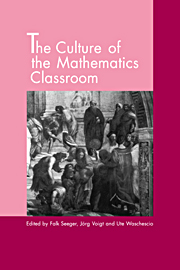Introduction
Published online by Cambridge University Press: 03 May 2010
Summary
The present volume explores the culture of the mathematics classroom. “Classroom culture” is a concept signaling a change of perspective on education at many levels: on those of the practice of teaching and learning as well as on research and theoretical approaches. This change of perspective on classroom processes is reflected in the attempt to capture their complexity and their wholistic character as fundamentally social processes of making sense and meaning.
While the concept of classroom culture is presently gaining some currency (see, e.g., Bruner 1996), this volume nicely reflects that, as a paradigm, it is still in the making.
Before presenting the individual chapters in this volume, we shall outline some of the fundamental questions related to this emerging paradigm.
There is some tension between “culture” as somehow general and “classroom culture” as somehow specific; between “culture” as a pregiven frame of teaching–learning processes and “classroom culture” as something to be constructed; between culture as something to be appropriated and something to be created. The question, then, is how “classroom culture” relates to “culture at large,” how “sharing the culture” relates to “creating culture,” and how sharing a particular culture may relate to sharing culture at large.
There is another tension in the concept of classroom culture: Are the influences that culture exerts on learning more direct or more indirect? The meaning of culture and cultivation has always been related directly to education and development.
- Type
- Chapter
- Information
- The Culture of the Mathematics Classroom , pp. 1 - 10Publisher: Cambridge University PressPrint publication year: 1998



